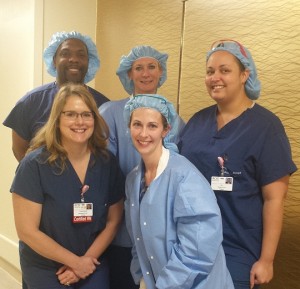 Few people can say they’ve seen firsthand what goes on in a surgery room.
Few people can say they’ve seen firsthand what goes on in a surgery room.
If you’ve had a surgery performed, you were probably asleep and missed all the action. There’s a good chance the image you have in your head is something similar to the chaos and drama portrayed in Grey’s Anatomy.
We’re here to debunk the myths that television puts in our heads and give you a behind the scenes look at the Surgery Department at OSF St. Joseph Medical Center.
Surgery nurse, Faith Frankeberger, RN, BSN, CNOR, took time to sit down and provide some insight into the department.
The Team
The Surgery Department includes nurses, technicians, anesthesiologists, and surgeons from various specialties like Orthopedics, Neurology, Urology, and more! The members of the department work closely as a team whether performing everyday tasks or during emergent situations – always making patients and their safety a top priority. With so many staff members involved in each surgical case, communication amongst all staff is vital to the patient’s safe care, and the team at OSF St. Joseph Medical Center does this extremely well!
“The OR does not operate like they portray on television medical dramas. It is a very controlled environment with a lot of highly trained staff who are excellent at what they do,” stated Faith.
So what does a day in the life of a Surgery nurse entail? Let us enlighten you.
A Day in the Life
Faith arrives in the Operating Room (OR) at 6 a.m. to set up their morning surgery cases. She attends a quick briefing at 6:30 a.m. to review the caseload for the day, and then returns to the OR. She then begins to open supplies and retrieve medication for the morning surgeries, ensuring the surgeon and technicians will have everything they need to begin in a timely matter.
After speaking with the patient and asking appropriate safety questions, the surgical nurse will take the patient back to the OR. Once in the room the circulating nurse will assist the anesthetist in positioning the patient, applying monitors, and during the intubation process. After the patient is asleep the nurse will continue with additional positioning related to the specific procedure and prepping the surgical area to decrease the risk of infection.
While the procedure is in progress, the nurse does the majority of the charting and assists with specimens, labs, ordering and checking any necessary blood products, and retrieving additional supplies. The overall sterility and safety of the patient during the procedure is monitored for the entirety of the case.
Once the case is finished, the nurses will relay the report to the Recovery Room nurse, complete the patient’s chart, and then head back to the OR to clean and get ready for the next surgery. Faith’s schedule varies anywhere from one very long case to three or four shorter cases in an eight-hour period.
“It all gets done at a very fast pace, but it gets done with the help of everyone,” said Faith.
Behind Closed Doors
Surgery seems to be a place of uncertainty, because it is closed off from the rest of the hospital in its own area with “Restricted” signs and locked doors. But behind those closed doors is a team of nurses, scrub technicians, ancillary staff, surgeons, and anesthesia personnel who have the warmest of hearts and who do their best every day to make each patient feel safe, loved, and cared for.
“Most of our patients may not remember those who cared for them during surgery and that’s ok,” says Faith. “We want our patients to take with them the memory of feeling comfortable and safe.”
Photo: From top left is James Haggins, Patient transporter/Surgical aid; Marni Woolridge, RN; Ivy Wiley, Surgical tech; Crystal Cargill, RN, Recovery; and Faith Frankeberger, RN, BSN, CNOR.
Last Updated: February 15, 2018